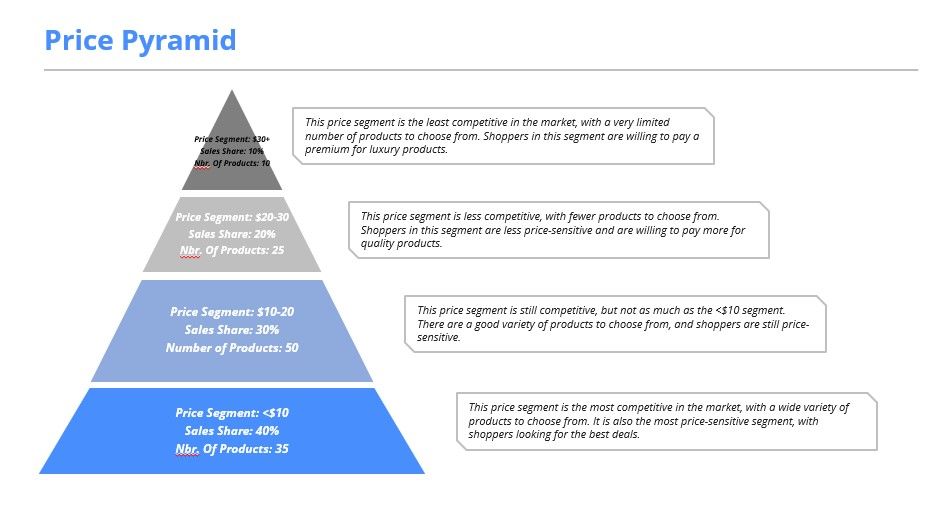
🎓 Definition
The Price pyramid visually represents the sales share (value volume) of the Category by Price Segment. These price segments can be the same as defined in the Price Structure or different.
The key benefit of the Price pyramid is to identify around what Selling Price level most of the Shoppers are buying the Product. It also helps identify the level of choice (and therefore competition) in every price segment.
🧪 Example of Price Pyramid

❓What is used for
- To improve profitability: Pyramid pricing is a simple way to determine your product price and improve profitability. So your profit will increase if you price strategically.
- To minimize erosion and maximize profits over time: Pyramid pricing is combined to form a strategic pricing pyramid for a deep understanding of how products create value for our customers. So, it is the key to improving the price structure that determines how your offerings should be priced.
- To discover what consumers value about your product: Discovering this can allow a Retailer to increase the price of products.
- To avoid price wars from multiple competitors: Sometimes there are multiple competitors who produce the same product at the same price as you. The only way to compete is to offer a discount or some promotion. Pyramid pricing might be the key to avoiding price wars.
How do businesses typically collect data to construct a Price Pyramid for their products?
Businesses typically collect data to construct a Price Pyramid for their products through market research, sales data analysis, and customer feedback. This data is essential to understand the sales share of the category by different price segments and identify where most shoppers are making their purchases.
Are there specific industries or types of products where the Price Pyramid strategy is most effective?
The Price Pyramid strategy can be effective across various industries and product types. However, it may be particularly beneficial for industries with a wide range of product offerings and price points, such as retail, consumer electronics, and automotive sectors. In these industries, understanding the price sensitivity and buying behavior of consumers can provide valuable insights for strategic pricing decisions.
Can the Price Pyramid be used in conjunction with other pricing strategies, and if so, how do they complement each other?
Yes, the Price Pyramid can be used in conjunction with other pricing strategies to enhance overall pricing effectiveness. For instance, businesses can combine the Price Pyramid with dynamic pricing, value-based pricing, or penetration pricing strategies. By integrating these approaches, businesses can create a more comprehensive and adaptive pricing strategy that considers both market demand and competitive dynamics.